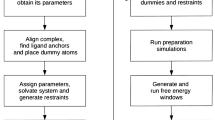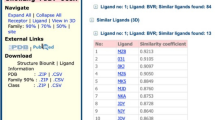Abstract
TO validate procedures of rational drug design, it is important to develop computational methods that predict binding sites between a protein and a ligand molecule. Many small molecules have been tested using such programs, but examination of protein–protein and peptide–protein interactions has been sparse. We were able to test such applications once the structures of both the maltosebinding protein1 (MBP) and the ligand-binding domain of the aspartate receptor2, which binds MBP, became available. Here we predict the binding site of MBP to its receptor using a 'binary docking' technique in which two MBP octapeptide sequences containing mutations that eliminate maltose chemotaxis are independently docked to the receptor. The peptides in the docked solutions superimpose on their original positions in the structure of MBP and allow the formation of an MBP–receptor complex. The consistency of the computational and biological results supports this approach for predicting protein–protein and peptide–protein interactions.
This is a preview of subscription content, access via your institution
Access options
Subscribe to this journal
Receive 51 print issues and online access
$199.00 per year
only $3.90 per issue
Buy this article
- Purchase on Springer Link
- Instant access to full article PDF
Prices may be subject to local taxes which are calculated during checkout
Similar content being viewed by others
References
Spurlino, J. C., Lu, G.-Y. & Quiocho, F. A. J. biol. Chem. 266 (8), 5202–5219 (1991).
Milburn, M. V. et al. Science 254, 1342–1347 (1991).
Manson, M. D. & Kossmann, M. J. Bact. 165, 34–40 (1986).
Kossmann, M., Wolff, C. & Manson, M. D. J. Bact. 170, 4516–4521 (1988).
Gardina, P., Conway, C., Kossman, M. & Manson, M. D. J. Bact. 174, 1528–1526 (1992).
Goodsell, D. & Olson, A. Proteins Struct. Funct. Genet. 8, 195–202 (1991).
Mowbray, S. L. & Koshland, D. E. Jr Cell 50, 171–180 (1987).
Falke, J. J. & Koshland, D. E. Jr Science 237, 1596–1600 (1987).
Milligan, D. & Koshland, D. E. Jr Science 254, 1651–1654 (1991).
Kirkpatrick, S., Gelatt, C. D. Jr & Vecchi, M. P. Science 220, 671–680 (1983).
Gasteiger, J. & Marsili, M. Tetrahedron Lett. 34, 3181–3184 (1978).
Goodford, P. J. J. med. Chem. 28, 849–857 (1985).
Author information
Authors and Affiliations
Rights and permissions
About this article
Cite this article
Stoddard, B., Koshland, D. Prediction of the structure of a receptor–protein complex using a binary docking method. Nature 358, 774–776 (1992). https://doi.org/10.1038/358774a0
Received:
Accepted:
Issue Date:
DOI: https://doi.org/10.1038/358774a0
This article is cited by
-
Three-dimensional structure and function study on the active region in the extracellular ligand-binding domain of human IL-6 receptor
Science in China Series C: Life Sciences (2000)
-
Bovine β–lactoglobulin modified by 3–hydroxyphthalic anhydride blocks the CD4 cell receptor for HIV
Nature Medicine (1996)
-
Distributed automated docking of flexible ligands to proteins: Parallel applications of AutoDock 2.4
Journal of Computer-Aided Molecular Design (1996)
-
Flexible ligand docking using a genetic algorithm
Journal of Computer-Aided Molecular Design (1995)
-
Prediction of the binding sites of huperzine A in acetylcholinesterase by docking studies
Journal of Computer-Aided Molecular Design (1994)
Comments
By submitting a comment you agree to abide by our Terms and Community Guidelines. If you find something abusive or that does not comply with our terms or guidelines please flag it as inappropriate.



